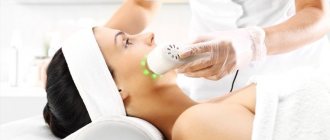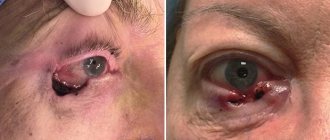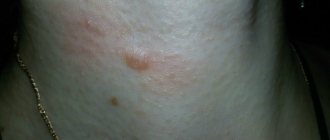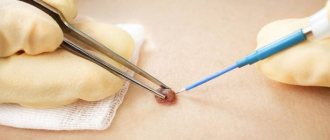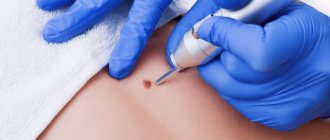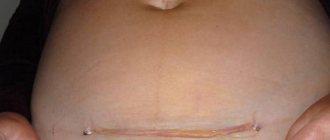How long should you not sunbathe after mole removal?
Within 14 days after laser removal of a mole, the epidermis forms under the scab. After the crust has fallen off, thin newly formed skin is visible at the removal site. The epidermis (surface layer) has not yet had time to accumulate melanin in the cells, a substance that protects our body from ultraviolet radiation. This means that this place becomes vulnerable and it is in this zone that processes of improper cell division can begin. Therefore, after laser removal of not only moles, but also other neoplasms or blood vessels on the skin, direct exposure to sunlight on this area should be avoided for at least 2 months. Or, while tanning, cover the areas with a fabric that reliably protects the area from the sun (cotton shirt and trousers).
What to do if the nevus begins to grow after removal?
Why did it happen?
Maybe I should have chosen a different removal method? Maybe you need to change doctor? First of all, contact the doctor who performed the mole removal procedure. It is he who has the most reliable information about the nevus itself and his actions with it. What to do next? This is already a matter of trust. If trust in the doctor is retained, correct him; if not, you need to choose another specialist. But any intervention, especially a surgical one, should be approached soberly, balancedly and without unnecessary emotions.
With laser or radio wave removal, the risks of relapse arise not so much because of the lack of nevus cells horizontally, but because of the lack of vertical removal, that is, deep into the skin.
In different types of moles and in different areas of the skin, nevus cells can lie deep enough in the dermis and at different levels, which can cause local relapse.
If a mole recurs, you can resort to excision of the scar with recurrent growth, but in my opinion this is an overly aggressive approach. It should only be used if histological examination was not performed at the time of removal, and the recurrence looks suspicious regarding the growth of melanoma.
Is it dangerous for moles to appear at the site of removal?
No, it's not dangerous!
This is not my subjective opinion, this is data from many studies conducted. There is no evidence of an increased risk of melanoma at the site of a removed nevus. Another thing is that the removal of the mole itself was carried out as a preventive measure against the formation of melanoma, which means that if a local relapse occurs, this risk remains. Since the desired result has not been achieved, it is necessary to carefully remove the nevus.
Typically, additional removal is carried out using the same method that was used during the patient’s initial treatment. That is, as a rule, resurfacing of a recurrent nevus is carried out using a laser or radio wave method.
Is it necessary to perform a histological examination of recurrent nevus?
This can be done, but is not always necessary.
If a removed nevus has been examined histologically, then a recurrent one should be examined only if there is a suspicion of malignancy. If histology of the removed nevus was not carried out, and the primary removal was not carried out in our clinic, we will definitely send the material for histological examination. In conclusion, I want to say that, of course, the occurrence of a recurrence of a mole is an unpleasant situation for both the patient and the doctor. But it is very simple to correct this situation without any harm to health and appearance - contact a specialist to remove the recurrence of the nevus.
We professionally care about the beauty and health of your skin. If you are concerned about the appearance of moles after removal, make an appointment with an oncodermatologist
by phone, +7 (812) 318-59-90, and we will help you solve this problem.
Why you shouldn't sunbathe after mole removal
In the previous answer we partially answered the question. In the area of the epidermis that is not formed after laser removal, the risk of neoplasia (improper cell division) increases with the risk of developing cancer cells in the future. The second reason is the risk of age spots. The mechanism is almost the same. The weak, immature epidermis, trying to protect itself under the influence of sunlight, begins to actively produce the pigment melanin. This process goes faster than in nearby undamaged skin. Therefore, the intensity of skin coloring under the rays of the sun is different. A hyperpigmented area appears at the site where the mole was removed by laser.
What to do after radical removal of melanoma?
After therapy is completed, doctors will continue to monitor the patient closely. Along with the risk of recurrence of melanoma, other complications may occur. Postoperative monitoring of the patient's condition will include:
- regular examination of the skin and the condition of the lymph nodes - independently and by a doctor;
- depending on the stage of the disease, control instrumental studies (X-ray, PET, CT, etc.) may be needed;
- in some cases, to prevent recurrence of skin melanoma, techniques using radiation therapy (local irradiation of the tumor defect area), as well as protocols using immune drugs, can be used.
In some cases, after surgical treatment of melanoma, protocols using irradiation of the tumor defect area are used to prevent local tumor recurrence. Although this approach does not guarantee a reduction in the incidence of distant metastasis, according to statistics, it reduces the likelihood of local relapse.
Recently, techniques using intensity-modulated radiotherapy have been actively introduced into practice, which allows for maximum focusing of radiation with minimal damage to healthy tissue.
The use of stereotactic radiosurgery for metastatic melanoma makes it possible to directly irradiate the tissue of the secondary tumor, which limits the rate of its malignant growth.
The use of immunodrugs and the use of targeted therapy in the treatment of common tumors in 70% of cases makes it possible to transfer tumor cells to a “switched off” state. At the same time, intoxication is reduced, quality and life expectancy are increased.
How does laser mole removal work?
The procedure for removing moles is standard and includes several stages:
- Examination of the skin by a dermatologist to exclude the presence of signs of melanoma. There is a classification of 5 criteria for which the doctor must examine and check the formation. Shape, size, color, surrounding tissue, density. Sometimes dermatoscopy (examination of an element under multiple magnification) can be used for diagnosis. Having completely convinced that the formation is benign, the specialist begins the removal procedure itself.
- Consultation before the procedure. The dermatologist talks about how the procedure will take place and the symptoms that will accompany it. Possible complications and limitations that will occur after the manipulation.
- Signing the patient's informed consent for the administration of anesthetic and laser vaporization.
- Next, he proceeds directly to removing the mole. The area is treated with a skin antiseptic. An anesthetic injection is given. After complete freezing, the mole is removed within healthy tissue using a CO laser. Repeated treatment with a disinfecting solution is carried out.
- Recommendations for care.
Prevention of scars at the site of nevus
In most cases, the risk of skin scarring depends on the method used to perform the excision surgery. The highest probability of such an outcome after use:
- acids;
- cryodestructive method (liquid nitrogen);
- if surgical excision with a scalpel is performed.
Least likely when using coagulators. These include:
- high temperature laser;
- radio wave method (radio knife, or better known name Surgitron);
- electric shock method (known as electrocoagulation or electric knife).
Speedy healing ensures proper care of the painful area. If a suture is applied, it must be removed in a timely manner. Regular dressings, the use of special creams, and ensuring the integrity of the surface will help protect against the growth of connective tissue.
Proper adherence to all recommendations for wound care after removal of a birthmark will prevent the likelihood of complications, and the healing process will be more effective.
Which doctor should I contact to remove a mole?
Laser mole removal is performed by a doctor who has been trained in the use of laser technology. Depending on the area of localization of the mole and its characteristics, the specialists to whom patients turn may be the following:
- dermatologist when placing the element on the torso, limbs, scalp;
- doctor - dermatocosmetologist if the formation is on the face, including other localizations;
- an oncologist if there is a large mole, or one that has recently increased in size or changed color;
- gynecologist when a tumor is located in the intimate area.
MOLES CANNOT BE REMOVED IF:
You are pregnant
I do not recommend removing moles during pregnancy for two reasons:
- All drugs from the group of local painkillers have pregnancy in the list of contraindications.
- In my experience, you are more likely to develop a scar during pregnancy.
This, of course, does not apply to situations where it is necessary to remove a mole for oncological reasons.
If you have a pacemaker
Radioknife and electrocoagulation are contraindicated. In such cases, removal should only be done with a laser or scalpel.
At the same time, there is evidence that many modern pacemakers do not respond to radio waves or electrical current. In any case, you must be informed that you have a pacemaker before any operation, regardless of its scope.
5. How many days does it take for a wound to heal after a mole is removed?
After removal, a dry crust remains on the skin. This is coagulated tissue. Underneath, healing and restoration of the skin begins to take place. After 7-10 days, this crust falls off on its own. Under no circumstances should you tear it off prematurely. The primary formed scar after the scab has fallen off is still different from the surrounding tissue. Regeneration processes continue in it and complete restoration of the structure ends by the 20th day. The area may still differ in color from the surrounding tissue, since the pigment accumulated in the cells is not equally distributed. But after a month it will be impossible to distinguish the place where the removal took place.
Limitations and complications after laser mole removal
Specific requirements must be strictly adhered to for four weeks after surgery, regardless of how quickly healing occurs. In particular, you should refrain from visiting a solarium and sunbathing, and do not visit the pool or sauna to protect your skin from any infectious diseases. It is also recommended not to drink alcohol, as they dilate blood vessels, often causing bleeding. In case of removal of a mole on the face, you should not apply decorative cosmetics to the skin for 7-10 days after the operation.
Cosmetics with a softening effect speed up the skin restoration process.
As for complications after a laser procedure, they can occur if you do not comply with the doctor’s requirements and do not pay proper attention to the damaged area. In such cases, negative symptoms occur that require immediate contact to the clinic for additional treatment. These complications include:
- prolonged bleeding;
- purulent discharge;
- significant swelling of the skin that does not go away for several days;
- increased temperature of the whole body or area around the wound;
- severe itching.
Laser mole removal how to care
After laser mole removal, the following is recommended:
Immediately after removal, slight swelling and redness may be observed around the wound, which goes away within 1-3 days.
Take care of the crust that has formed after removal so that it does not fall off or tear off prematurely. It protects the wound from infection. Wear clothing that protects this area and do not scratch it.
If symptoms such as redness of the skin around the crust, swelling, pain, sanguineous or purulent discharge appear, immediately contact the clinic where the mole was removed with a laser .
While the crust protects the wound, there is no need to treat it with anything additional. After the scab has separated, to accelerate epithelization, you can apply a cream with dexpanthenol, solcoseryl, etc.
Follow the restrictions: solarium and insolation for up to 2 months; do not go to the bathhouse, sauna, or bath for 14 days; Avoid alcohol intake for the first 3 days; During the period until the scab falls off, cosmetics are not applied to this area.
Treatment of removed nevus
Comprehensive wound care after mole removal includes:
- antiseptic treatment procedures;
- dressings;
- the use of ointments with antibiotics of a healing nature.
It usually takes 2-3 weeks for the wound to completely heal, but if the birthmark was large, it may take longer. When choosing products for treatment, it is better to consult a specialist. The dermatologist will recommend the most effective medications, taking into account the characteristics of the patient’s body.
Ointments and creams
There are various ointments, creams for treating and caring for the wound surface. Some have a wound-healing effect, others neutralize pathogenic flora. Most modern drugs have a complex effect.
Levomekol is a combination drug for local treatment of wounds. It has pronounced antibacterial, anti-inflammatory and wound-healing properties. Relieves pain, redness, swelling. The drug contains the antibiotic chloramphenicol and methyluracil, which improves tissue trophism. The medicine helps to carry out proper care after removing a problematic mole.
Thanks to its mild, gentle action, Levomekol can be applied to a wound. This is relevant if a bacterial infection has occurred and pus is released from the damaged area. In this case, it is recommended to warm it up to human body temperature. More often, a gauze bandage soaked in ointment is used to treat nevi. It is recommended to use the ointment within 4 days after the operation.
Contractubex belongs to a group of drugs that normalize the process of tissue regeneration. The gel contains liquid onion extract, allantoin, and sodium heparin. The product has antiproliferative, anti-inflammatory, antiallergic, and softening effects. The drug inhibits the growth of fibroblasts, suppressing non-physiological scar formation.
The product is used at the stage of scar formation to prevent the development of colloids. Treatment involves daily application of the gel to the problem area. Treatment can be carried out several times a day. For large areas of damage, you can smear it under a bandage after removing the mole, leaving it overnight.
For the treatment of wound surfaces the following may be prescribed:
- tetracycline ointment;
- Levosin;
- salicylic ointment;
- Agrosulfan;
- Solcoseryl;
- Dermazin;
- Baneocin;
- Vishnevsky ointment;
- Pantoderm;
- boric ointment;
- zinc or streptocidal ointment.
Before using any pharmaceutical product, you must consult a doctor, carefully study the instructions for the drug, and follow the recommendations of a dermatologist.
Potassium permanganate solution or Fukortsin
Antiseptic solutions are used to treat affected areas to prevent bacterial infections that will cause the sore to fester. The most popular disinfectants are potassium permanganate and Fukortsin.
Potassium permanganate or potassium permanganate is a crystalline powder, dark purple in color with a metallic sheen. Potassium permanganate is a strong oxidizing agent. Even when diluted in water, it has strong properties.
It is advisable to treat wounds with a permanganate solution of 0.1-0.5%. To do this, you need to count out 6-8 powder crystals. It is better to add the substance to warm water in a glass container. If you cannot determine the proportion, you can dilute the solution “by eye.” The color of the water after thorough mixing should be rich, like red wine.
Having prepared the solution, you can begin to treat the wound. To do this, dip a cotton swab into potassium permanganate and gently wipe the surface of the former mole. It is recommended to treat nearby skin areas. Carry out the procedure daily before applying a special cream.
Fukortsin is a ready-made solution of dark red color. After application, a characteristic pink color remains on the skin. The main effect of the drug is to disinfect wound surfaces and treat bacterial inflammation. Available in glass bottles. The use of Fukortsin is relevant during the healing of the wound surface of a removed nevus. During application, which should be carried out with a cotton swab, avoid contact with the mucous membranes of the body. It is advisable to carry out treatment 1–3 days before the problem area heals.
For treatment it is possible to use Chlorhexidine, Furacilin, brilliant green, chamomile infusion, hydrogen peroxide.
Bandage or patch
Plasters and dressings are the main attributes in the process of treating wound areas. Instead of the usual bandages and adhesive plaster, modern medicine uses special devices that protect the wound and promote speedy healing.
The Hydrocol Syn dressing is intended for the treatment of poorly healing wounds. Thanks to the properties of the special gel with which the cut is impregnated, exudate is absorbed and healing is stimulated. It does not allow water or bacterial pathogens to pass through. If there is exudate, the bandage is changed daily; if there is no discharge, it can be worn for several days.
Silicone patch Mepiform is intended for the resorption of hypertrophic and colloidal scars, which sometimes occur after healing of a wound from a birthmark. Available in small sections and large bandages, which can be cut if desired. The treatment period is long, taking up to 8 months.
Laser mole removal takes a long time to heal.
The healing time depends on the size of the mole, location, and individual characteristics of the regenerative processes.
If they are small in size, up to 0.5 cm, moles heal in 10-14 days; if they are larger than 1 cm, regeneration takes up to 3-4 weeks.
In places with good blood supply and in open areas of the body, healing is faster, up to 14 days. In places that are subject to friction (belt, bra line, groin area), get wet (perineum, armpits), have thick skin and poor blood flow (sole, palm), healing takes up to 4 weeks.
What happens when minimally invasive surgery is stopped?
Everyone is frightened by the results of surgical intervention - the location of the eliminated nevus turns into an open wound. Specialists disinfect it with an antiseptic. They force the patient to be especially careful about hygiene in order to protect the wound from infection until it is completely healed - the formation of a crust of dense consistency.
Everything usually heals within 10-14 days. If, when eliminating a benign neoplasm, the deep layers of the skin were affected, a scar will form (after removal of the mole). This is a normal recovery process. Similar results from such interventions are common. This is due to the individuality of each person’s body.
What causes a scar to appear after mole removal?
Large area of dermis treatment (when the nevus is too large). The healing ability of skin tissue also affects. It is individual for each person. When eliminating nevi of the same size on the body of two different patients, it may turn out that one will have a scar as a result of the recovery period, but the second will not. Other factors that provoke the appearance of a scar:
- the location of a benign tumor above the blood vessels (this leads to the accumulation of an excessive amount of collagen fibers);
- presence of diabetes mellitus;
- infection (healing time increases, risk of scar formation increases);
- constant touching of hands to a fresh open wound;
- not drinking water/vitamins every day (while the recovery period lasts);
- reluctance to use disinfectants and softening ointments.
The likelihood of a scar occurring after mole removal also increases if the patient constantly scratches the scar site, wears uncomfortable clothing that causes injury to the open wound, experiences a sharp surge in hormones, or has unique genetic characteristics that provoke the appearance of a scar.
If you have a scar after removing a mole and you are not satisfied with its presence on your body, then contact a medical center. Most clinics use the laser method of scar removal because it is more effective, painless, and absolutely safe for the body.
How is the mole removal procedure performed?
What is laser mole removal ? If the neoplasm is quite large, then first the upper part of the mole is surgically cut off. The lower one is removed using a high-precision laser to the very root. Laser removal is absolutely painless and safe. The only discomfort this procedure causes is that the site of the former mole may be very itchy during healing. But it is not difficult to get rid of this if you follow all the instructions of your doctor. He will prescribe special healing medications that will help cope with the negative consequences.
Laser technology is also applicable to remove papillomas and other skin growths.
The process of removing moles with a laser takes only about 20-60 minutes, depending on the size of the neoplasm and its depth. And most often, just one procedure of laser removal of tumors is enough to forget about the annoying problem forever. Only in extremely rare cases will additional therapy be required.
You can find photos after removing a mole directly on our website. It is not difficult to notice that the healing process takes approximately 5 months. And it is after using the laser that the reviews after mole removal are the most positive. There are no wounds, no pain, or any other discomfort. After the procedure, you can return to your normal life, no longer afraid of damaging the mole or relapse. This is excluded if you had the removal performed in our clinic.
By the way, it wouldn’t hurt to take a photo of the place after removing the mole. This way you can make sure that after a while the formation does not begin to grow again.
How long will the healing process take?
Many are also interested in the question: how long does it take for a mole to heal after removal? This depends on many indicators, ranging from the area of skin that was exposed to the laser to the depth of impact on the epidermis. At the same time, the healing process is in many ways very individual. For some this process takes several weeks, for others it takes 6 months. Here the regenerative qualities of each patient’s body play a big role.
But in general, there are general stages that healing after laser mole removal in Moscow involves. Initially, the formation may take on a slightly darkish tint. In this case, most often a small notch is formed after the laser. After just a few weeks, there will be no indentation at all, only a small pigment spot will remain, which will completely disappear after 5 months. The place where the mole was previously will take on a slightly lighter shade. This can easily be eliminated with regular tanning.
If you are very concerned that after removing a mole with a CO2 laser, there will be no noticeable mark left, you can consult a cosmetologist. He will prescribe the use of certain ointments that will help speed up the healing process. But still, experts recommend doing without medications at this stage. The scar will not be visible only when it heals at the normal speed that the regenerative function of the human body allows.
Are there complications after mole removal?
Only if the procedure was performed by an inexperienced doctor without prior research. The biggest risk is when a small part of the mole (just a few cells) may remain. This will be enough for it to start growing again, but as melanoma. Therefore, you should immediately emphasize to yourself that negative consequences after removing a mole can only arise when the procedure is performed by an inexperienced doctor. Therefore, approach the issue of choosing a clinic responsibly. By the way, the removal of warts must also be carried out especially carefully and completely, since the remaining cells lead to more intensive growth of a new wart.
Laser mole removal in Moscow at the LazerJazz clinic is carried out only by professional specialists using methods accepted throughout the world. Particular attention is paid to preparing for the procedure, determining the safest method and establishing possible contraindications to laser mole removal.
